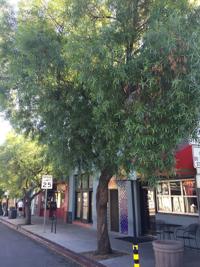Q: I have a love/hate relationship with this “weed.” For about 10 years I cut it off at the ground. It came up as one puny stalk with a reddish stem and then got other stems growing next to it and I’ve seen it in other places where it volunteers near drip emitters. I always wanted a real tree in that corner but couldn’t afford it. About three years ago I thought: maybe if I let it grow and tied it up, it would get a strong enough stem to become a tree, sort of… so I did that. Looking it up on line, I thought it looked very like an African Willow. So now it is strong enough to support itself, but I really don’t feel like giving it a tree status. What the heck is it? Its perseverance has finally got my grudging admiration. It won the battle.
A: Your tree is called African sumac (Rhus lancea) and it is a very common plant in our area. They can grow to a height and width of 30 to 40 feet. Once they become large trees, some people like them for the shade they provide. They are tough and do well with little care and may be used as street trees or in places where little else will grow well. Unfortunately, they are invasive and can spread easily in urban areas. Their seeds will grow wherever there is available water. As you know, persistence is required to keep them down once they start growing. Some people report allergies to the pollen so that is another concern. It’s hard to say no to a free tree but this is one that you might consider removing given the associated problems it brings.
Peter L. Warren is the urban horticulture agent for the Pima County Cooperative Extension and the University of Arizona. Email questions to tucsongardensage@gmail.com





